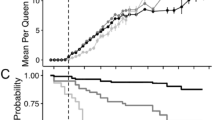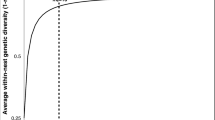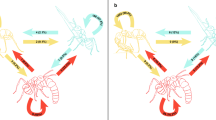Abstract
Division of labor is a key factor in the ecological success of social groups. Recent work suggests that division of labor can emerge even without specific adaptations for task specialization and that it can appear in incipient social groups as a self-organizational property. We investigated experimentally how selection and self-organization may interact during the evolution of division of labor by examining task performance in groups of normally solitary versus normally social ant queens. We created social pairs of colony-founding queens from two populations of the ant Pogonomyrmex californicus, one in which queens are normally solitary and one in which queens form foundress groups, and observed their behavior during nest excavation. In both populations, one of the two queens usually performed most of the excavation, becoming the excavation specialist. We could predict which queen would become the specialist based on their relative propensities to perform the task in other contexts, consistent with a variance-based model of task specialization. The occurrence of specialization even when group members were not adapted to social life suggests that division of labor may well have been present in incipient queen groups. However, division of labor can result in cost skew among group members, and thus, paradoxically, within-group selection may constrain or even reduce specialization. Consistent with this effect, pairs of normally solitary queens were significantly more asymmetrical in their task performance than normally social pairs, in which both queens nearly always performed the behavior to some degree.




Similar content being viewed by others
References
Bartz SH, Hölldobler B (1982) Colony founding in Myrmecocystus mimicus (Hymenoptera: Formicidae) and the evolution of foundress associations. Behav Ecol Sociobiol 10:137–147
Bernasconi G, Keller L (1996) Reproductive conflicts in cooperative associations of fire ant queens. Proc R Soc Lond B 263:509–515
Bernasconi G, Strassmann JE (1999) Cooperation among unrelated individuals: the ant foundress case. Trends Ecol Evol 14: 477–482
Beshers SN, Fewell JH (2001) Models of division of labor in social insects. Annu Rev Entomol 46:413–440
Bonabeau E, Theraulaz G, Deneubourg J-L (1996) Quantitative study of the fixed threshold model for the regulation of division of labour in insect societies. Proc R Soc Lond B 263:1565–1569
Bonabeau E, Theraulaz G, Deneubourg J-L (1998) Fixed response thresholds and the regulation of division of labor in insect societies. Bull Math Biol 60:753–807
Brown MJF, Bonhoeffer S (2003) On the evolution of claustral colony founding in ants. Evol Ecol Res 5:305–313
Cahan S, Helms KR, Rissing SW (1998) An abrupt transition in colony founding behaviour in the ant Messor pergandei. Anim Behav 55:1583–1594
Calderone NW, Page RE (1992) Effects of interactions among genotypically diverse nestmates on task specialization by foraging honey-bees. Behav Ecol Sociobiol 30:219–226
Clutton-Brock TH, Gaynor D, Kansky R, MacColl ADC, McIlrath G, Chadwick P, Brotherton PNM, O’Riain JM, Manser M, Skinner JD (1998) Costs of cooperative behaviour in suricates (Suricata suricatta). Proc R Soc Lond B 265:185–190
Fewell JH, Page RE (1993) Genotypic variation in foraging responses to environmental stimuli by honey-bees, Apis mellifera. Experientia 49:1106–1112
Fewell JH, Page RE (1999) The emergence of division of labour in forced associations of normally solitary ant queens. Evol Ecol Res 1:537–548
Fewell JH, Page RE (2000) Colony-level selection effects on individual and colony foraging task performance in honeybees, Apis mellifera L. Behav Ecol Sociobiol 48:173–181
Gamboa GJ, Stump KA (1996) The timing of conflict and cooperation among cofoundresses of the social wasp Polistes fuscatus. Can J Zool 74:70–74
Gordon DM (1989) Dynamics of tasks switching in harvester ant. Anim Behav 38:194–204
Hagen RH, Smith DR, Rissing SW (1988) Genetic relatedness among co-foundresses of two desert ants Veromessor pergandei and Acromyrmex versicolor. Psyche 95:191–201
Helms Cahan S (2001) Ecological variation across a behavioral transition zone in the ant Messor pergandei. Oecologia 129:629–635
Helms Cahan S, Blumstein DT, Sundström L, Liebig J, Griffin A (2002) Social trajectories and the evolution of social behavior. Oikos 96:206–216
Hemelrijk CK (2002) Understanding social behaviour with the help of complexity science. Ethology 108:655–671
Hogeweg P, Hesper B (1983) The ontogeny of interaction structure in bumble bee colonies: a MIRROR model. Behav Ecol Sociobiol 12:271–283
Hölldobler B (1976) Recruitment behavior, home range orientation and territoriality in harvester ants, Pogonomyrmex. Behav Ecol Sociobiol 1:3–44
Hunt J, Simmons LW (2002) Behavioural dynamics of biparental care in the dung beetle Onthophagus taurus. Anim Behav 64:65–75
Jeanne RL (1996) Regulation of nest construction behaviour in Polybia occidentalis. Anim Behav 52:473–488
Johnson RA (1998) Foundress survival and brood production in the desert seed-harvester ants Pogonomyrmex rugosus and P. barbatus. Insectes Soc 45:255–266
Johnson RA (2000) Water loss in desert ants: caste variation and the effect of cuticle abrasion. Physiol Entomol 25:48–53
Johnson RA (2002) Semi-claustral colony founding in the seed-harvester ant Pogonomyrmex californicus: a comparative analysis of colony founding strategies. Oecologia 132:60–67
Julian GE, Cahan S (1999) Undertaking specialization in the desert leaf-cutter ant, Acromyrmex versicolor. Anim Behav 58:437–442
Krebs RA, Rissing SW (1991) Preference for larger foundress associations in the desert ant Messor pergandei. Anim Behav 41:361–363
Oster GF, Wilson EO (1978) Caste and ecology in social insects. Princeton University Press, Princeton, N.J.
Page RE (1997) The evolution of insect societies. Endeavor 21:114–120
Page RE, Mitchell SD (1998) Self-organization and the evolution of division of labor. Apidologie 29:171—190
Reeve HK, Gamboa GJ (1987) Queen regulation of worker foraging in paper wasps : a social feedback control system. Behaviour 102:147–167
Reeve HK, Keller L (1997) Reproductive bribing and policing evolutionary mechanisms for the suppression of within-group selfishness. Am Nat 150: S42–S58
Rissing SW, Pollock GB (1987) Queen aggression, pleometrotic advantage and brood raiding in the ant Veromessor pergandei. Anim Behav 35:975–981
Rissing SW, Johnson RA, Martin JW (2000) Colony founding behavior of some desert ants: geographic variation in metrosis. Psyche 103:95–101
Robinson GE (1992) Regulation of division of labor in insect societies. Annu Rev Entomol 37:637–665
Robinson GE, Page REJ (1989a) Genetic basis for division of labor in an insect society. In: Breed MD, Page REJ (eds) The genetics of social evolution. Westview, Boulder, Colo., pp 61–80
Robinson GE, Page RE (1989b). Genetic determination of nectar foraging, pollen foraging, and nest-site scouting in honey bee colonies. Behav Ecol Sociobiol 24:317–323
Sakagami SF, Maeta Y (1987) Sociality, induced and/or natural, in the basically solitary small carpenter bees. In: Ito Y, Brown JL, Kikkawa J (eds) Animal societies: theories and facts. Japan Science Society, Tokyo, pp. 1–16
Sommer K, Hölldobler B (1995) Colony founding by queen association and determinants of reduction in queen number in the ant Lasius niger. Anim Behav 50:287–294
Theraulaz G, Bonabeau E, Deneubourg JL (1998) Response threshold reinforcement and division of labour in insect societies. Proc R Soc Lond B 265:327–332
Trivers RL (1971) Evolution of reciprocal altruism. Quart Rev Biol 46:35–57
Underwood DLA, Shapiro AM (1999) Evidence for division of labor in the social caterpillar Eucheira socialis. Behav Ecol Sociobiol 46:228–236
Waloff N (1957) The effect of the number of queens of the ant Lasius flavus on their survival and on the rate of development of the first brood. Insectes Soc 4:391–408
Wcislo WT (1997) Social interaction and behavioral context in a largely solitary bee, Lasioglossum figueresi. Insectes Soc 44:199–208
Wilson EO (1971) The insect societies. Harvard University Press, Cambridge, Mass.
Wilson EO (1975) Sociobiology. Harvard University Press, Cambridge, Mass.
Wilson EO (1976) Behavioral discretization and the number of castes in an ant species. Behav Ecol Sociobiol 1:141–154
Acknowledgments
Our heartfelt thanks to the many people from the Social Insect Research Group at ASU who contributed to watching queens at all hours, especially Glennis Julian and Ekwutosi Okoroh. Thanks also to Bob Johnson and Liz Smith for queen collection in 1994, and to Emma Harrison for collection and weighing assistance. This work was supported in part by an NIMH grant R29 MH51329 to J.H.F. Additional financial support during manuscript preparation was provided by grants from the Swiss National Foundation to L. Keller.
Author information
Authors and Affiliations
Corresponding author
Additional information
Communicated by J. Heinze
Rights and permissions
About this article
Cite this article
Helms Cahan, S., Fewell, J.H. Division of labor and the evolution of task sharing in queen associations of the harvester ant Pogonomyrmex californicus . Behav Ecol Sociobiol 56, 9–17 (2004). https://doi.org/10.1007/s00265-003-0746-5
Received:
Revised:
Accepted:
Published:
Issue Date:
DOI: https://doi.org/10.1007/s00265-003-0746-5




